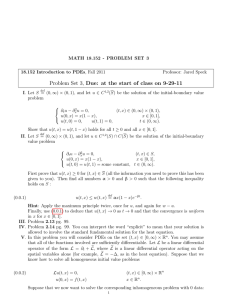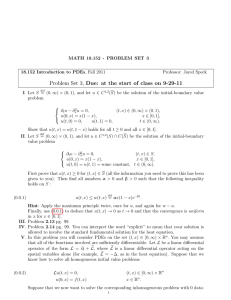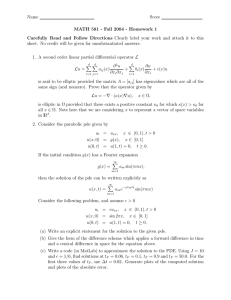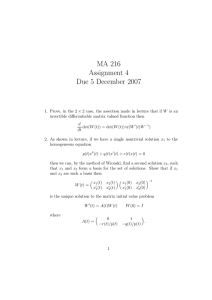in u
advertisement
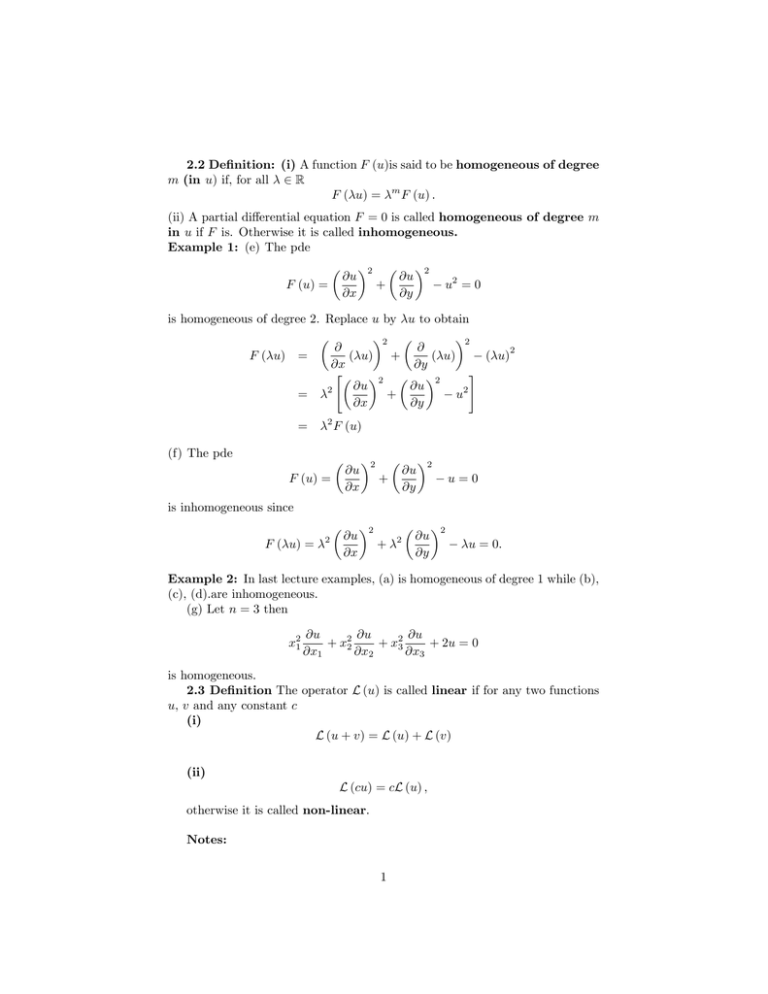
2.2 De…nition: (i) A function F (u)is said to be homogeneous of degree m (in u) if, for all 2 R F ( u) = m F (u) : (ii) A partial di¤erential equation F = 0 is called homogeneous of degree m in u if F is. Otherwise it is called inhomogeneous. Example 1: (e) The pde F (u) = @u @x 2 2 @u @y + u2 = 0 is homogeneous of degree 2. Replace u by u to obtain F ( u) = = = @ ( u) @x " @u 2 @x 2 2 + 2 2 ( u) 2 @u @y + 2 @ ( u) @y u 2 # F (u) (f) The pde F (u) = @u @x 2 @u @x 2 @u @y + 2 u=0 is inhomogeneous since F ( u) = 2 + 2 @u @y 2 u = 0: Example 2: In last lecture examples, (a) is homogeneous of degree 1 while (b), (c), (d).are inhomogeneous. (g) Let n = 3 then x21 @u @u @u + x22 + x23 + 2u = 0 @x1 @x2 @x3 is homogeneous. 2.3 De…nition The operator L (u) is called linear if for any two functions u, v and any constant c (i) L (u + v) = L (u) + L (v) (ii) L (cu) = cL (u) ; otherwise it is called non-linear. Notes: 1 (i) 2.3(ii) states that L is homogeneous of degree 1. (ii) To see whether a pde is linear it su¢ ces to substitute cu + v for u. It is linear , L (cu + v) = cL (u) + L (v) : (iii) De…ne L to consist only of those terms which contain u so if the linear pde contains a term f (x; y) independent of u then write Lu = f: Example 3: In operator format, let I denote the identity operator, i.e. Iu = u (a) Lu = 0 L = 2 @ @ +3 @x @y 7I; (b) Lu = 3x @ @ L = x + x2 y ; @x @y (c) L = x21 @ @ @ + x22 + x23 +I @x1 @x2 @x3 Lu = 0 Example 4: In last lecture examples, (a), (b) are linear, (c), (d) are nonlinear, while in example 2, (e) (f) are non-linear, (g) is linear, e.g. (a) L (u) = 2 so L (cu + v) = 2 c 2 @u @u +3 @x @y 7u = 0 @ @ (cu + v) + 3 (cu + v) @x @y @ @ +3 @x @y 7I u + 2 @ @ +3 @x @y = cL (u) + L (v) : 2 7 (cu + v) = 0 7I v = 0 whereas, for (e) (put F (cu + v) = c to see that it is not homogeneous of degree 1) @ (cu + v) @x = = c2 2 = c " 2 @u @x + 2c @u @x 2 + 2 + @ (cu + v) @y @u @v + @x @x @u @y = c2 F (u) + F (v) + 2c 2 @v @x # u2 + 2 2 (cu + v) 2 @u @y + c2 @v @x @u @v @u @v + @x @x @y @y 2 + 2 + 2c @v @y @u @v + @y @y 2 v 2 + 2c @v @y uv showing that (g) is nonlinear. Let the function u = u (x; y). 2.4a De…nition A linear …rst order pde for u (x; y) may be written in the form @u @u + b (x; y) = c (x; y) u + d (x; y) @x @y where the coe¢ cients a,b,c; d are known functions of the independent variables x; y. Note: In operator notation write Lu = d L = a @ @ +b @x @y cI Nonlinear pdes are classi…ed as follows: 2.4b De…nition A semi-linear …rst order pde for u may be written a (x; y) @u @u + b (x; y) = c (x; y; u) @x @y where a,b, are known functions of x; y and c = c (x; y; u) is a known function of x; y; u which is nonlinear in u. Note: (i) c is a function of u (but not of derivatives of u). (ii) d = d (x; y), independent of u, has been absorbed into c (x; y; u). 3 c2 u2 2cuv @u @v @u @v + 2c @x @x @y @y 6= cF (u) + F (v) a (x; y) 2 v2
